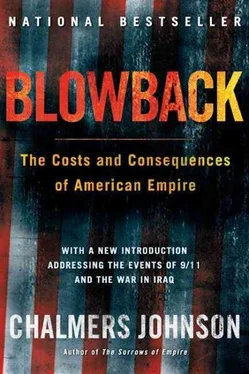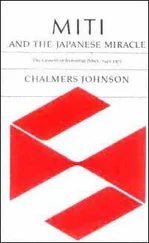Chalmers Johnson - Blowback, Second Edition - The Costs and Consequences of American Empire
Здесь есть возможность читать онлайн «Chalmers Johnson - Blowback, Second Edition - The Costs and Consequences of American Empire» весь текст электронной книги совершенно бесплатно (целиком полную версию без сокращений). В некоторых случаях можно слушать аудио, скачать через торрент в формате fb2 и присутствует краткое содержание. Год выпуска: 0101, ISBN: 0101, Издательство: Macmillan, Жанр: Старинная литература, на английском языке. Описание произведения, (предисловие) а так же отзывы посетителей доступны на портале библиотеки ЛибКат.
- Название:Blowback, Second Edition: The Costs and Consequences of American Empire
- Автор:
- Издательство:Macmillan
- Жанр:
- Год:0101
- ISBN:9780805075595
- Рейтинг книги:5 / 5. Голосов: 1
-
Избранное:Добавить в избранное
- Отзывы:
-
Ваша оценка:
- 100
- 1
- 2
- 3
- 4
- 5
Blowback, Second Edition: The Costs and Consequences of American Empire: краткое содержание, описание и аннотация
Предлагаем к чтению аннотацию, описание, краткое содержание или предисловие (зависит от того, что написал сам автор книги «Blowback, Second Edition: The Costs and Consequences of American Empire»). Если вы не нашли необходимую информацию о книге — напишите в комментариях, мы постараемся отыскать её.
Blowback, Second Edition: The Costs and Consequences of American Empire — читать онлайн бесплатно полную книгу (весь текст) целиком
Ниже представлен текст книги, разбитый по страницам. Система сохранения места последней прочитанной страницы, позволяет с удобством читать онлайн бесплатно книгу «Blowback, Second Edition: The Costs and Consequences of American Empire», без необходимости каждый раз заново искать на чём Вы остановились. Поставьте закладку, и сможете в любой момент перейти на страницу, на которой закончили чтение.
Интервал:
Закладка:
Two days after the article appeared, the Pentagon announced that the underground A-bomb plant actually seemed to be a large hole in the ground—one of thousands of such holes, some of them containing whole factories that were sited underground after the devastating American bombing during the Korean War—and that the United States had no evidence the North Koreans had ceased to comply with the Agreed Framework. Analysts in Asia speculated that if North Korea did decide to pull out of the agreement, it need only restart its reactors at its nuclear research center at Yongbyon instead of building a brand-new, inherently risky and expensive underground reprocessing plant. In Europe, the IAEA’s spokesman said that the international monitoring agency first heard of the alleged new nuclear site from the New York Times .
Dr. C. Kenneth Quinones, who from 1992 to 1994 was the State Department’s desk officer for North Korea and subsequently the Asia Foundation’s representative in South Korea—as well as the American who probably has visited the North more often than any other—wrote, “This . . . story is centered in Washington, not in Pyongyang. It involves America’s intelligence community and not North Korea’s nuclear program. . . . The recent leak of unsubstantiated ‘intelligence’ certainly appears to have been an irresponsible effort by a ‘pessimist’ within the American intelligence community. . . . The U.S. government has officially denied the accuracy of the reports.” 18Nonetheless, Secretary of State Madeleine Albright called the “suspected nuclear facility” a “huge threat” and demanded the right of the United States to conduct inspections in North Korea when and where it chooses. 19North Korea agreed to let Americans look into Kumchang-ri in return for food aid. When the inspection was completed, American officials disclosed that it was a huge, empty tunnel and that there was no evidence of any preparations to construct a nuclear reactor or install machinery of any kind in it. 20
In addition to these and other North Korean alarums, 1999 saw a number of strident but ultimately overstated U.S. claims about Chinese missile deployments and nuclear espionage, and unfortunate “accidents” (the U.S. bombing of the Chinese embassy in Belgrade during the Kosovo war). These raised serious questions about whether the armed and intelligence services were either out of control or being manipulated for political ends.
This is not to say that North Korea’s nuclear and missile programs are not serious problems. Since there is as yet no worldwide treaty banning them, nor an effective defense against them, all programs to develop nuclear weapons and long-range missiles, including those of the United States and Japan, are “destabilizing.” They constitute the most dangerous offensive weapons in existence at the present time. The issue is what to do about them. North Korea remains isolated in part because of policies the United States has pursued over the past forty-five years. To be sure, these policies were first formulated during the Cold War, but with the end of the old postwar order in East Asia, we finally have a chance to help promote a peaceful reunification of the Korean peninsula. Instead, the Pentagon is promoting a ballistic missile defense system. Surely no better illustration exists of our continued imperial ambitions and delusions.
It is also worth remembering that what we call the Korean War ended as a war between the United States and China fought on Korean soil. Had it been strictly a “Korean” war in which only the United States intervened, the side we supported would have been militarily victorious and Korea today would not be divided. If the Korean peninsula ever erupts again into open warfare, China, an active participant in the Korean War, would undoubtedly once again consider intervention. China today actually seems most interested in a perpetuation of the status quo on the Korean peninsula. Its policy is one of “no unification, no war.” Not unlike the eighth- and ninth-century Tang dynasty’s relations with the three Korean kingdoms of Koguryo, Silla, and Paekche, China presently enjoys diplomatic relations with both Koreas and may prefer a structurally divided peninsula. A Korea unable to play its obvious role as a buffer between China, Russia, and Japan would give China a determining influence there. China’s greatest worry has been that the Communist state in the North may collapse due to economic isolation and ideological irrelevance, thereby bringing about a unified, independent, and powerful new actor in northeast Asian politics, potentially the size of and as rich as the former West Germany and defended by a good army, possibly armed with nuclear weapons—not a development the Chinese would necessarily welcome.
For all of these reasons, the United States should cultivate North Korea and become an active supporter of Korean unification. In return for unification, the United States should withdraw its forward-deployed land forces from East Asia but retain its role as a balancer and provider of a “nuclear umbrella.” A unified, economically successful Korea would help ensure a genuine balance of power in East Asia rather than the hegemony of either China, Japan, or the United States. Such a policy would also be a more effective way of instilling prudence in the foreign policy of an emerging China than our current pretense that we have the will, money, or patience to “contain” China.
CHINA: THE STATE
OF THE REVOLUTION
On June 29, 1998, on a state visit to China, President Bill Clinton addressed the students of Beijing University in a speech carried live by television to all parts of China and then responded to their questions. One young man asked, “With a friendly smile, you have set foot on the soil of China. . . . So we are very excited and honored by your presence. What the Chinese people really aspire for is the friendship between China and the United States on the basis of equality. And I know that before your departure from the States, you said that the reason for you to visit China is because China is too important and engagement is better than containment. I’d like to ask you whether this is a kind of commitment you made for your visit, or do you have any other hidden things behind this smile? Do you have any other design to contain China?” 1
This was a good question. Two years earlier the president had mobilized two carrier task forces when China launched a dramatic rocket barrage as part of its “military exercises” in the vicinity of Taiwan. These symbolic gestures were clearly aimed by the People’s Republic at the upcoming Taiwanese presidential elections, and were a response as well to an unprecedented visit by the Taiwanese president to the United States the previous year. The exercises were meant as reminders to both governments that the mainland would never look on Taiwan as anything other than a province of China, and the American response, equally symbolic and crude, was a sobering reminder to the Chinese of the massive military forces the United States maintains and is capable of deploying just off their coast. Ironically though, from the point of view of American policy goals, Clinton’s show of force had the unintended effect of helping the government in Beijing overcome its loss of legitimacy following the collapse of communism in Europe and its repression of its own students and workers in Tiananmen Square in 1989. Much as did Japanese aggression in the 1930s, American saber rattling rallied ordinary Chinese behind their government.
Since those aircraft carriers appeared in the waters off Taiwan in the spring of 1996, the United States has signed agreements with Japan enlarging the latter’s military commitments, undercutting its pacifist constitution, and securing its acquiescence in remaining a privileged sanctuary for American military operations. The issue of the territories and waters in East Asia covered by these agreements has been deliberately obscured: the U.S. government insists the area to be “protected” includes the Taiwan Strait, while the Japanese government insists it does not (and neither government has been candid with its citizens about the major ambiguities in the new agreements).
Читать дальшеИнтервал:
Закладка:
Похожие книги на «Blowback, Second Edition: The Costs and Consequences of American Empire»
Представляем Вашему вниманию похожие книги на «Blowback, Second Edition: The Costs and Consequences of American Empire» списком для выбора. Мы отобрали схожую по названию и смыслу литературу в надежде предоставить читателям больше вариантов отыскать новые, интересные, ещё непрочитанные произведения.
Обсуждение, отзывы о книге «Blowback, Second Edition: The Costs and Consequences of American Empire» и просто собственные мнения читателей. Оставьте ваши комментарии, напишите, что Вы думаете о произведении, его смысле или главных героях. Укажите что конкретно понравилось, а что нет, и почему Вы так считаете.










